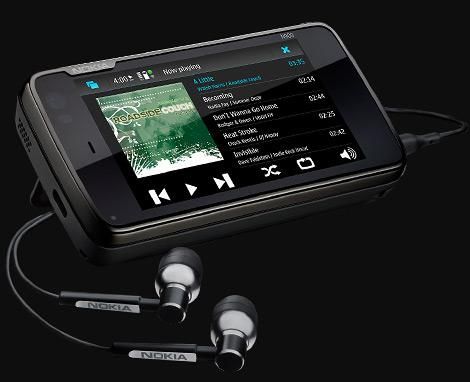The Nokia N900 is a powerful machine running a Linux core with Maemo Linux as its operating system, and more specifically Maemo 5. Nokia gave us a tour of the device at CTIA in October, and now the device is shipping in unlocked form for $570, quite the drop from its intended $650 MSRP when the device initially was slated for shipment in November. Like Google Android, Maemo 5 is based on Linux; however, unlike Android, Nokia has promised to retain the power of Linux by keeping Maemo relatively open and accessible to users and developers. Unlike many other Nokia phones, this one does not use the Symbian platform, though traces of Symbian—like the icons and the layout of apps—can be found on the device.
At its core, Maemo 5 shares some of the UI underpinnings of Android—the device has homescreens—4 to be exact—for widgets and shortcuts, capable applications, and a robust, zippy user experience. Upon initial impressions, there are areas where Maemo excelled though, and Nokia did a good job. First, the camera is excellent and carries the hallmarked Nokia N series multimedia capabilities with the Carl Zeiss lens. The camera can capture videos with autofocus with its 5-megapixel camera with dual flash and videos at 30 frames per second at widescreen 480 X 800 DVD-quality resolution.
Second, the web browser, based on Mozilla technology—the same stuff behind Firefox—renders pages effortlessly and flawlessly—with Adobe Flash 9.4 support. Zooming in web pages could be achieved in a number of ways, including double tap to zoom, utilization of the volume hardware keys to zoom in and out, and gestures by creating a clockwise motion to zoom in and counter-clockwise to zoom out.
Third, the phone feature is well thought out and can allow for integration with Skype and other VOIP technologies.
In some areas, though, Maemo 5 feels underwhelming, especially when compared with other modern smartphone operating systems. For one, it was designed and geared towards power users, and not consumers, so some of the oddities are to be expected. As a user experience, the N900 is intended as an internet tablet first, and it seems that in doing so, Nokia failed to make use of the accelerometer to auto-rotate to portrait mode when the device is held vertically—the firm is working on a fix for that.
Though I wasn't bothered with the keyboard and the spacebar in the three-row arrangement, it may deter some users but the on-screen keyboard should mitigate any fears. Applications were limited for the Maemo 5 system. Though Nokia has other internet tablets before the N900, there are relatively few programs available for Maemo 5 and the official Maemo 5 Ovi Store isn't yet open. Additionally, where as the Microsoft Office viewers created by Dataviz called Documents to Go is available for free on webOS and Android (the editor is available for a small premium), the viewer is slated to be "on sale" for $10 for Maemo 5. In due time, hopefully we'll be able to recognize the potential of Linux and Maemo 5 as more developers create compelling apps for the platform, but at this time it seems that the device's great powers are not fully utilized.
Those who expect the "Linux" core behind Maemo 5 to represent a full scale Linux based computer may be disappointed—there isn't a version of Open Office yet for Maemo 5, you can't install general Linux applications on the device, and there are UI constraints to get a few applications to properly work if they weren't specifically designed for Maemo 5. However, there is great potential behind the platform that has yet to be realized—it has a capable PIM system, good email, amazing browser, excellent multi-tasking skills, a brilliantly colorful display, and all the goodness that an N Series device promises.
It will take time for developers to port their applications and the platform to catch on. While the Maemo 5 operating system isn't as consumer friendly as Google Android, its counter-culture, openness and extensibility will definitely attract those who want to "hack" their device and modify some of its OS.
The device also has a great build quality with a bright and easy to use resistive touchscreen—it's almost as responsive as a capacitive touchscreen. The screen is at WVGA resolution and measures 3.5-inch diagonally. The built-in kickstand is great for setting the device on a desk and watching a video.
There's also a front-facing VGA web camera, light sensor, LED notification light, Bluetooth, accelerometer, WiFi, and GPS on board, though a turn-by-turn GPS app is not available at this time but third-party Sygic has promised a GPS app will come by year's end. The 32 GB of on-board storage, expandable to a theoretical 64 GB with a 32 GB micro SDHC card, 1 GB of application memory (of which 256 MB is reserved for RAM), and 600 MHz ARM Cortex processor makes performance and multi-tasking a breeze.
It's unfortunate though that the N900 is only available unlocked in unsubsidized form in the States. It is compatible with T-Mobile USA AWS 3G network and can work on AT&T on EDGE or WiFi. Because it's unsubsidized, it will carry a higher price tag of around $550, placing it out of the reach of some customers. However, for those that want power, openness and flexibility, the N900 will be a hard phone to beat. It will take some time for the world to fully realize the power behind Maemo 5.
For more details on the Maemo 5 OS or the N900, you can visit the Nokia site for information.
Stay tuned with pocketnow.com as we will continue to explore the Maemo OS and the N900 and follow up with our complete impressions in the coming weeks.

